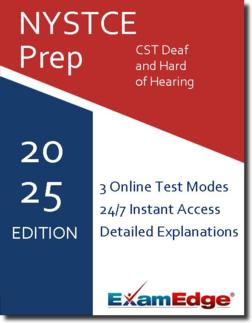NYSTCE CST Deaf and Hard of Hearing (063) Practice Tests & Test Prep by Exam Edge - Topics
Based on 34 Reviews
- Real Exam Simulation: Timed questions and matching content build comfort for your NYSTCE CST Deaf and Hard of Hearing test day.
- Instant, 24/7 Access: Web-based NYSTCE CST Deaf and Hard of Hearing practice exams with no software needed.
- Clear Explanations: Step-by-step answers and explanations for your NYSTCE exam to strengthen understanding.
- Boosted Confidence: Reduces anxiety and improves test-taking skills to ace your NYSTCE CST Deaf and Hard of Hearing (063).

Understanding the exact breakdown of the NYSTCE CST Deaf and Hard of Hearing test will help you know what to expect and how to most effectively prepare. The NYSTCE CST Deaf and Hard of Hearing has 90 multiple-choice questions and 1 essay questions. The exam will be broken down into the sections below:
| NYSTCE CST Deaf and Hard of Hearing Exam Blueprint | ||
|---|---|---|
| Domain Name | % | Number of Questions |
| Foundations of Deaf Education | 13% | 15 |
| Knowledge of Students Who Are Deaf or Hard of Hearing | 13% | 15 |
| Assessment and Individual Program Planning | 13% | 15 |
| Strategies for Planning and Managing the Learning Environment and for Providing Behavioral Interventions | 13% | 15 |
| Instructional Planning and Delivery to Promote Students' Success in the General Curriculum | 14% | 16 |
| Strategies for Teaching Language, Communication, and Social Skills | 14% | 16 |


